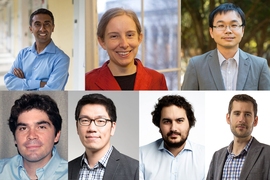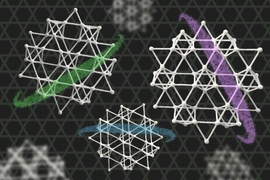The Gordon and Betty Moore Foundation has awarded MIT Associate Professor of Physics Joseph G. Checkelsky a $1.7 million Emergent Phenomena in Quantum Systems (EPiQS) Initiative grant to pursue his search for new crystalline materials, known as “quantum materials,” capable of hosting exotic new quantum phenomena.
Quantum materials have the potential to transform current technologies by supporting new types of electronic and magnetic behavior, including dissipationless transmission of electricity and topological protection of information. Designing and synthesizing robust quantum materials is a key goal of modern-day physics, chemistry, and materials science.
However, this task does not have a straightforward recipe, particularly as many of the most exciting quantum systems are also the most complex. “The starting point can be viewed as the periodic table of the elements and the geometrically allowed ways to arrange them in a solid. The path from there to a new quantum material can be circuitous, to say the least,” Checkelsky says.
“In our group we are trying to come up with new methods to find our way to these new quantum systems,” he says. “This usually requires a fresh perspective on crystalline motifs.”
One example of these unique electronic structures is the kagome crystal lattice formed when atoms of iron (Fe) and tin (Sn) combine into a pattern that looks like a Japanese kagome basket, with a repeating pattern of corner-sharing triangles. Checkelsky, together with Class of 1947 Career Development Assistant Professor of Physics Riccardo Comin, graduate students Linda Ye and Min Gu Kang, and their colleagues reported in 2018 that a compound with a 3-to-2 ratio of iron to tin (Fe3Sn2) generates Dirac fermions — a special kind of electronic state supporting exotic electronic behavior protected by the topology, or geometric structure, of atoms within the material.
More recently, the MIT team and colleagues elsewhere reported in Nature Materials that, in a 1-to-1 iron-tin compound, the symmetry of the kagome lattice is special, simultaneously hosting both infinitely light massless particles (the Dirac fermions) and infinitely heavy particles (which manifest experimentally as flat bands in the electronic structure of the material). These unique electronic structures in iron-tin compounds could be the basis for new topological phases and spintronic devices.
For many years, the idea that a metal with atoms arranged in a kagome lattice of corner-sharing triangles could support unusual electronic states, such as combining both massless and infinitely massive electrons, remained a textbook problem — something that could be solved with equations but had not been experimentally shown in a real material. It was, Checkelsky notes, thought of as a “toy” model, something so simplified that it might seem unrealistic that a real lattice would do that. “But something about it being so simple helps you cut to the heart of the most interesting physics,” he says. “By doing our best to force this into an actual crystal, we managed to bridge that gap from the abstract to the real in a quantum material.”
“To try to find new quantum materials is a challenge,” Checkelsky says. “Typically for our group, we think about different kinds of lattices that might support these interesting states. The generous support of the Gordon and Betty Moore Foundation will help us pursue new methods to stabilize these materials beyond conventional approaches — giving us a chance to find exciting new materials.”
“It is also an opportunity to train people how to find new quantum materials,” he says. “This is a process that takes time, but is an important skill in the field of quantum materials and one to which I hope we can contribute.”
Last year, Checkelsky led an international team to discover a new type of magnetically driven electrical response in a crystal composed of cerium, aluminum, germanium, and silicon. The researchers call this response singular angular magnetoresistance (SAMR).
Like an old-fashioned clock that chimes at 12 o’clock and at no other position of the hands, the newly discovered magnetoresistance only occurs when the direction, or vector, of the magnetic field is pointed straight in line with the high-symmetry axis in the material’s crystal structure. Turn the magnetic field more than a degree away from that axis and the resistance drops precipitously. These results were reported in the journal Science.
This unique effect, which can be attributed to the ordering of the cerium atoms’ magnetic moments, occurs at temperatures below 5.6 kelvins (-449.6 degrees Fahrenheit). It differs strongly from the response of typical electronic materials, in which electrical resistance and voltage usually vary smoothly as an applied magnetic field is rotated across the material.
In July 2019, Checkelsky won a Presidential Early Career Award for Scientists and Engineers (PECASE), the highest honor bestowed by the U.S. government to science and engineering professionals in the early stages of their independent research careers.
The Gordon and Betty Moore Foundation fosters pathbreaking scientific discovery, environmental conservation, patient-care improvements, and preservation of the special character of the San Francisco Bay Area. Checkelsky’s Moore Foundation EPiQS Initiative Grant No. GBMF9070 is administered by the Materials Research Laboratory. The Materials Research Laboratory serves interdisciplinary groups of MIT faculty, staff, and students supported by industry, foundations, and government agencies to carry out fundamental engineering research on materials. Research topics include energy conversion and storage, quantum materials, spintronics, photonics, metals, integrated microsystems, materials sustainability, solid-state ionics, complex oxide electronic properties, biogels, and functional fibers.










